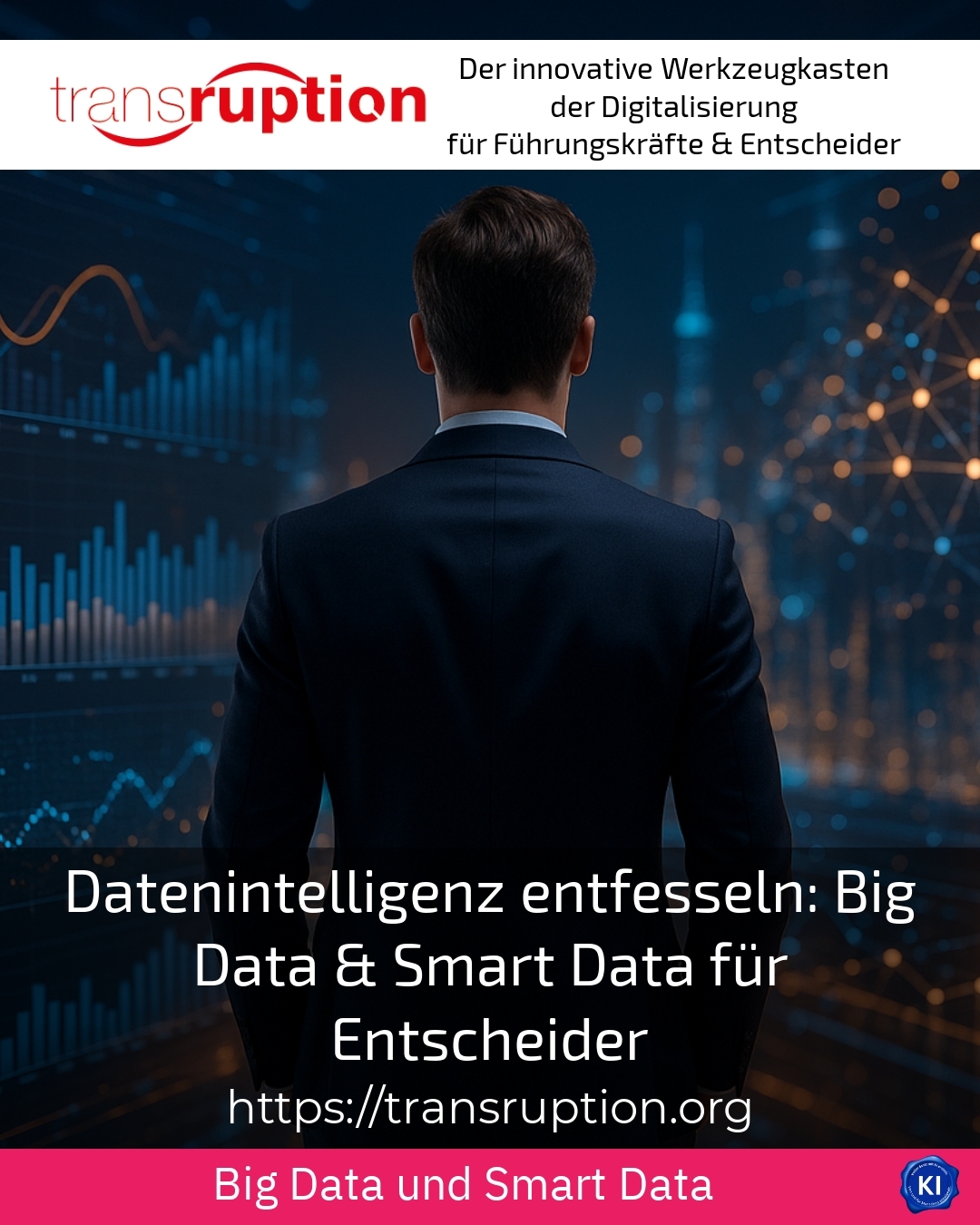In an increasingly networked, digital world, data intelligence takes centre stage: it determines how well companies can understand the growing data streams and use them to achieve their goals. Decision-makers are faced with the challenge of extracting relevant information from large amounts of data - big data - and transforming it into practical, action-orientated insights - smart data. As a transruption coach, I accompany this process by helping companies to systematically develop their data intelligence and thus lay the foundation for sustainable, data-driven decisions.
Basics: Understanding big data and smart data
Big data refers to huge, multi-layered amounts of data that come from different sources and can be both structured and unstructured [8][9]. The classic characteristics are volume (quantity), velocity (speed), variety (diversity), veracity (accuracy) and value [9]. Companies collect information from production processes, customer contacts, social media and digital applications on a daily basis.
But more data does not automatically mean more insight or value. Decision-makers turn to me because they often report being overwhelmed by the flood of data. They are looking for ways to select, process and meaningfully analyse the right data. This is exactly where the next step comes in: the transformation from big data to smart data.
Data intelligence in practice: from data collection to decision-making
Smart data is data that has already been filtered, cleansed and contextualised. It provides targeted, high-quality information that is relevant to the respective use case [1][3]. Companies that make consistent use of data intelligence not only recognise patterns and trends, but also derive specific measures from them.
With the right focus, I support decision-makers in defining their corporate goals and deriving clear questions for data analysis. This makes it possible to filter out what really matters from a large amount of data. An example: A retailer analyses purchasing data in order to adapt product ranges to regional preferences and strengthen customer loyalty.
BEST PRACTICE at the customer (name hidden due to NDA contract) A manufacturer of consumer goods was faced with the challenge of increasing sales of individual products. In a joint coaching process, we structured the existing data sources, identified target groups and analysed the customer journey. By focussing on smart data, we were able to develop targeted marketing measures that significantly increased sales in the relevant target groups and measurably improved customer satisfaction.
Another example: financial service providers use data intelligence to recognise and contain fraud processes more quickly [9]. They analyse transaction data in real time and use automated alerts as soon as anomalies occur.
In the healthcare sector, data intelligence helps to identify at-risk patients at an early stage and initiate targeted preventative measures. This makes diseases such as diabetes or cardiovascular diseases more predictable and improves the quality of care [9].
How companies build up data intelligence in a targeted manner
The path to a data-intelligent organisation is a process that I systematically accompany as a coach. The aim is not only to generate knowledge from data, but also concrete options for action. I recommend three key steps to achieve this:
1. clearly define objectives and questions: Before data is collected and analysed, it must be clear which problem is to be solved or which opportunity is to be exploited. This is the only way to select the appropriate data sources and set priorities.
2. ensure data quality and relevance: It makes sense to filter and validate data as soon as it is collected. In this way, only the information that actually contributes to decision-making and increases the informative value is used [1][3].
3. use analytical methods in a targeted manner: Modern tools such as machine learning and predictive analytics help to recognise patterns and make predictions [4]. However, traditional analyses also provide valuable impulses if they are tailored to the respective issue.
Examples of the use of data intelligence
BEST PRACTICE at the customer (name hidden due to NDA contract) A logistics company wanted to optimise delivery times and reduce the error rate. As part of the coaching, sensor data from the vehicle fleet was combined with weather data and historical delivery times. The analysis revealed bottlenecks that could be eliminated through targeted route planning and predictive maintenance. Customer satisfaction increased significantly and operating costs fell noticeably.
Clients often report that they are looking for new impetus in the area of customer loyalty. Here, data intelligence can help to understand purchasing behaviour, develop personalised offers and systematically improve the customer experience [7].
BEST PRACTICE at the customer (name hidden due to NDA contract) A company from the energy supply sector wanted to digitalise its customer service. By integrating smart meter data, complaint analyses and social media feedback, an overall picture of customer expectations was created. This made it possible to implement targeted measures to improve service quality and reduce response times.
My analysis
Today, data intelligence is not a luxury, but a basic requirement for successful, sustainable business. The targeted use of smart data enables companies to overcome complex challenges and recognise opportunities at an early stage. It is not just about collecting data, but about establishing the right context, ensuring quality and deriving specific measures from the findings.
As a transruption coach, I see myself as a companion on this journey. I support decision-makers in developing their data strategy, reflecting on challenges and gaining new perspectives. Whether in sales, production or service - data intelligence provides the basis for innovation, efficiency and sustainable business success.
Further links from the text above:
Difference Between Big Data and Smart Data - Esa Automation[1]
Big Data Defined: Examples and Benefits | Google Cloud[8]
What Is Big Data - Oracle[9]
Big Data vs. Smart Data: Is More Always Better? - Netconomy[6]
From big data to smart data, processes and outcomes - i-SCOOP[10]
For more information and if you have any questions, please contact Contact us or read more blog posts on the topic TRANSRUPTION here.















